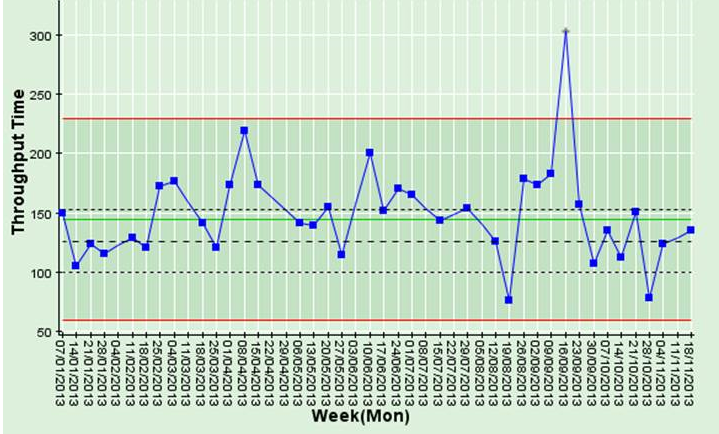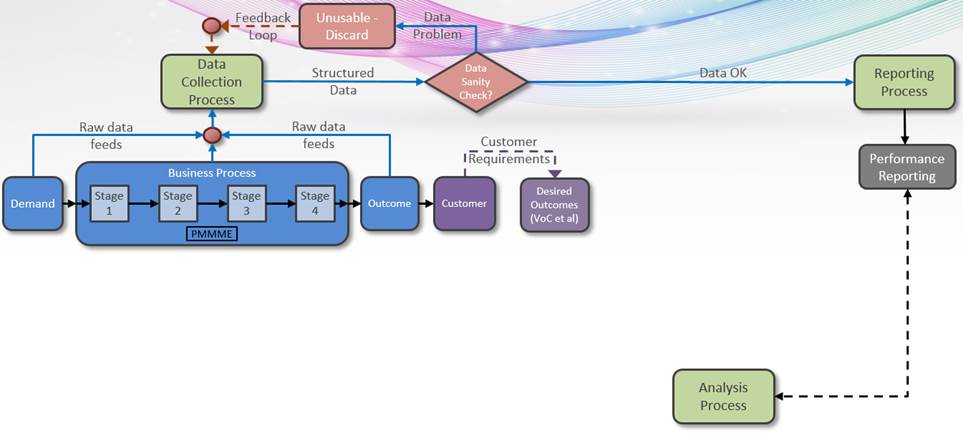Why Performance Reporting is NOT Performance Management! – Part 3
03/05/2017

We’ve enlisted the help of Jim Hacker from that well-loved series “Yes, Minister“, along with his trusty Principal Private Secretary Bernard Wooley to make a point for us this week:
Hacker: “Why can’t Ministers go anywhere without their briefs?”
Bernard: “It’s in case they get caught with their trousers down!”
And this is the problem with performance Reporting! Let’s look at a real example.
Rather than Police this week, we’ll look at a global pharmaceutical company delivering product to customers where they’ve committed to deliver to an agreed Service Level from order to delivery of 126 days at most.
Week on week reporting:
07/01/2013: 150 days: “Well, it was the first week back after New Year, what do you expect?”
14/01/2013: 106 days: “Well done!”
21/01/2013: 124 days: “Keep it up!”
28/01/2013: 117 days: “Your January bonus is secure”
11/02/2013: 131 days: “Not good enough, we’ll be caught with our trousers down and end up paying penalties if we don’t improve!”
18/02/2013: 114 days: “Great – back on track”
25/02/2013: 175 days: “What the *%!^?”
And so on…
Now if they’d been a bit more savvy, and were doing proper Performance Management rather than Performance Reporting, they’d be using a chart like the one below, where they could see that the average (green line) over time is just below 150 days. So this is not about what happened in week 11/02/2013 nor in week 25/02/2013 – the whole delivery process is failing to perform according to contract (represented by the longer dashed black line – 126 days). So they need to work on improving the whole process, not on what happened any one week. Although, by the way, there was a spectacular failure in the week of 16/09/2013 when the orders took over 300 days! This tells us also about what will happen in 2014 – they will continue to deliver on average at just under 150 days, but could take as long as 230 days (upper red performance guideline) or as little as 70 days (lower red performance guideline) unless there is a significant change to the process.

Last time we introduced the idea that Performance Reporting is not Performance Management and started to examine 3 aspects of this little conundrum:
- How can we better understand what has happened in the past (in order to take more appropriate action going forward)
- What can we say about what is likely to happen going forward (with/without any intervention)
- What are the fundamental differences between Performance Reporting and Performance Management
We’ve looked at the first 2 bullets; we’ll now start to address the third – What are the fundamental differences between Performance Reporting and Performance Management.
We’ll start with any business process – it could be Police incident response, Ambulance response, Delivery of pharmaceuticals, Maintaining the rail network…

There is some level of Demand coming in, the Demand is processed through a number (in this case 4) transformative (or value-add) stages consuming resources (PMMME = People, Material, Methods, Machines, Environment) and delivers an Outcome for the Customer which the Customer will evaluate according to Requirements. Typical IT solutions that implement these processes offer some form of reporting and so-called analytic capability by extracting usually a limited set of data from the IT system and producing reports. Sometimes IT will provide an “Analytics Tool”.

The problem is many-fold, in the “Management 1.0” approach. For example, there is no feed-forward into managing or improving the Business Process. Usually there is lots of animation and shouting/bullying/rewarding/gaming etc. Furthermore, the Data Collection Process (top left) isn’t seen as a process, it’s usually seen as “what can IT provide?”. Many times, the data is just a jumble from the activities in the Business Process, and it’s up to the so-called “Analysts” to sort it out. Hence, we see largely in every organisation Analysts are actually data collectors / manipulators / presenters. They do very little value-add Analysis and Recommendation on what to act on for improvement. If there was a Data Collection Process constituted correctly, it should provide structured data, and a Sanity Check would ensure it was broadly useful (and feed-back as appropriate). A Sanity Check does NOT mean “all data must be cleansed”. Just enough (usually more than 50%) needs to be good enough (again invoking Black Box Thinking – Matthew Syed).
So this is the usual Performance Reporting – disjoint from the Business Process, no feed-back into the Data Collection process and no feed-forward to Business Process Improvement, with Analysis spending most of its time in data manipulation. Sound familiar?
Next time, we’ll look at what might be regarded as something a bit more value-add…
Categories & Tags:
Leave a comment on this post:
You might also like…
Preparing for assignments and exams?
Sorry! We know it seems a bit mean to mention the exams in January rather than looking forward to the break before it! However, we know many of you will be thinking about your forthcoming ...
Screening for FTSE 100 companies on Bloomberg
So you’re researching an index and need some data on its constituent companies? Bloomberg’s Equity Screening tool makes light work of this, not just for the FTSE, but for indices, exchanges and sectors worldwide. Type EQS ...
Accelerating my future: How Cranfield put me on the fast track to automotive safety innovation
Hello! I’m Michaela Kaiser, and I’m thrilled to share my journey studying abroad. I’m from Calgary, Canada, and I recently graduated from Cranfield’s MSc Automotive Engineering course. My path to Cranfield ...
From Myanmar to Cranfield: My path to Renewable Energy
As someone who is passionate about sustainability, my career goal is to build a path in the renewable energy sector. My aspirations comes from the benefits of developing sustainable energy sources and ensuring energy ...
From lifelong dream to circular economy leader: Q&A with Himesha Randeni on the Environmental Management for Business MSc
What does it take to turn a lifelong passion for the planet into a fulfilling and impactful career? For Himesha Randeni, the answer was the Environmental Management for Business MSc at ...
Library services over the Christmas period
Kings Norton Library will be open 24/7 throughout the holiday period as a study space. Library staff will work until 6pm on Friday 19 December and will resume their normal working hours from 9am on ...






